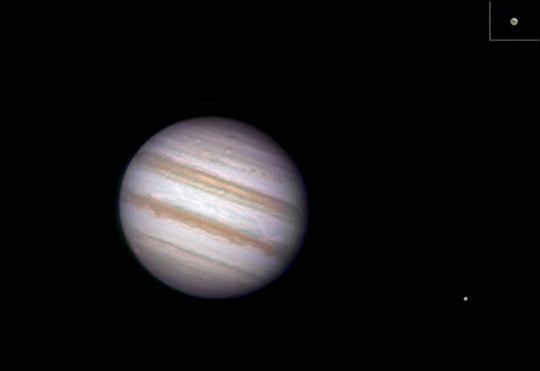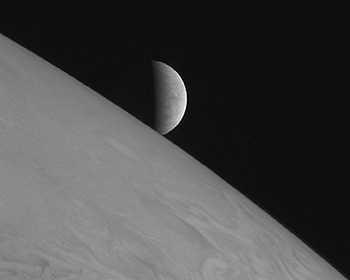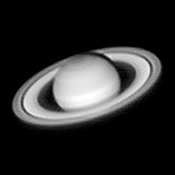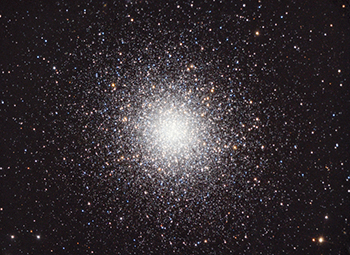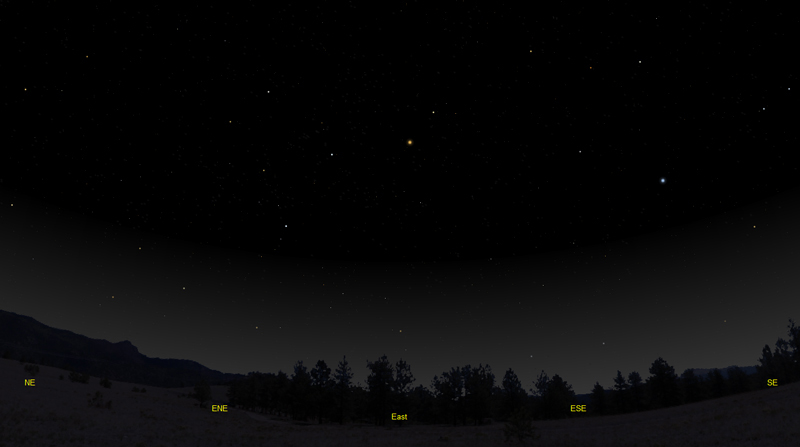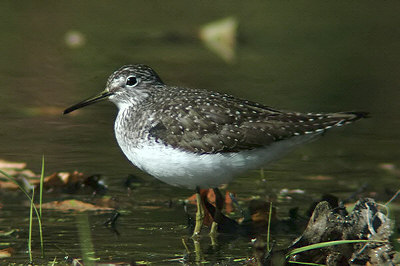The purpose of this feature is to give scout leaders, educators and naturalists an idea of some of the natural events coming up each month. We will try to cover a variety of natural events ranging from sky events to calling periods of amphibians, bird and mammal watching tips, prominent wildflowers and anything else that comes to mind. We will also note prominent constellations appearing over the eastern horizon at mid-evening each month for our area for those who would like to learn the constellations. If you have suggestions for other types of natural information you would like to see added to this calendar, let us know! Note: You can click on the hyperlinks to learn more about some of the featured items. To return to the Calendar, hit the "back" button on your browser, NOT the "back" button on the web page. All charts are available in a "printer friendly" mode, with black stars on a white background. Left clicking on each chart will take you to a printable black and white image. Please note that images on these pages are meant to be displayed at 100%. If your browser zooms into a higher magnification than that, the images may lose quality. Though we link book references to nationwide sources, we encourage you to support your local book store whenever possible.
Notes and Images From March 2014 I have a bit of a soft spot for Jupiter. When I was in high school, I worked long hours one winter grinding and polishing the mirror for my first reflecting telescope. When I completed it, Jupiter was the first thing I looked at. The great planet and its moons, seen against a twilight sky, was a beautiful sight. The little 6 inch reflector, with its cardboard tube and pipe-thread mount, was everything I could have hoped for.
On March 24th we did a little imaging of the planet with our 20 inch reflector, and it brought back many pleasant memories. Southern Leopard Frogs called the whole evening from our pond as I captured the images.
Europa was close to the planet that night, and I was surprised to find the images showed a little detail on its tiny disc. With an apparent diameter of less than one arc-second, it's like photographing a penny from a distance of two miles. Europa is one of the four "Galilean" moons, discovered by Galileo in 1610. It is thought to be a possible abode for life, as beneath its icy crust there may be an ocean of liquid water. As the New Horizons spacecraft sped by Jupiter in 2007, it took the striking image at right. Since then, New Horizons has been closing on Pluto, and its closest approach to that distant world will be on July 14th of this year. In our image, above the upper belt and to the left of center, you can see one of the younger red-tinted Jovian storms. Its resemblance to the Great Red Spot resulted in its nickname, The Little Red Spot, or just "Red Junior." It formed out of the union of several smaller storms around the year 2000. Its namesake is just coming around into the sunlight on the right limb of the planet, just above the top red belt. Jupiter dominates the planets, containing more than twice the mass of all of the other planets combined. Though it is 88,000 miles in diameter, it rotates in less than 10 hours, causing the equator to bulge out noticeably.
Sky Events for April 2015: A Total Lunar Eclipse occurs in the morning hours of April 4th. Unfortunately, totality does not occur until 6:54am, after the Moon has set. Only the partial phases of the eclipse will be visible for Middle Tennessee. The Lyrid Meteor Shower peaks in the early morning hours of April 23rd. This is typically a weak shower, producing only 15 to 20 meteors per hour in a dark sky location. However, the Moon will have already set, allowing good conditions from around 11:00pm till dawn, with the radiant high in the sky. Evening Sky: Venus shines bright in the evening sky after sunset all month long, climbing a little higher in the twilight sky each evening. By the 19th, you may be able to see Mercury very low in the western sky about 45 minutes after sunset. Binoculars will help find it (only use them after the sun has set). Incredibly, Mars may still be visible in binoculars within a few degrees of brighter Mercury on the 19th and for a few days after.
Jupiter is in Cancer this month. Look for it high above the southern horizon in the early evening. The cloud surface is constantly changing on Jupiter, and there's always something of interest to observe. The four "Galilean" moons are fun to watch from night to night and can be picked up in binoculars. Be sure to steady your arms against something solid to get the best view.
Morning Sky:
Saturn rises about 11:12pm (CDT) at the beginning of the month in Scorpius. Look for it low in the southeast. Saturn's rings have opened up to a nearly 24 degree tilt, giving a wonderful view of the ring system through just about any aperture telescope. Saturn transits around 4:21am and you will get your best view telescopically around that time. The view at right was taken on March 24th and shows the wide open aspect of the rings. All times noted in the Sky Events are for Franklin, Tennessee. These times should be pretty close anywhere in the mid-state area. Daylight Savings Time begins at 2:00am on March 8th.
Constellations: The views below show the sky looking east at 9:30pm CDT on April 15th. The first view shows the sky with the constellation outlined and names depicted. Star and planet names are in green. Constellation names are in blue. The second view shows the same scene without labels. Bright objects in the eastern sky this month include the stars Arcturus and Spica. New constellations are Serpens Caput, the Serpent (Head), and Hercules, the Strongman. As spring progresses and Hercules rises higher in the sky, look for the globular cluster Messier 13 (M13), which appears like a small fuzzy patch of light about 1/3 of the distance from Eta to Zeta Hercules (see illustration below). A cluster of stars about 21,000 light years away, M13 can be made out with the naked eye in a dark country sky when the constellation is high in the sky. Binoculars will help pick it out.
On Learning the Constellations: We advise learning a few constellations each month, and then following them through the seasons. Once you associate a particular constellation coming over the eastern horizon at a certain time of year, you may start thinking about it like an old friend, looking forward to its arrival each season. The stars in the evening scene above, for instance, will always be in the same place relative to the horizon at the same time and date each April. Of course, the planets do move slowly through the constellations, but with practice you will learn to identify them from their appearance. In particular, learn the brightest stars (Like Arcturus and Spica in the above scene looking east), for they will guide you to the fainter stars. Once you can locate the more prominent constellations, you can "branch out" to other constellations around them. It may take you a little while to get a sense of scale, to translate what you see on the computer screen or what you see on the page of a book to what you see in the sky. Look for patterns, like the stars that make up the constellation Corona Borealis. The earth's rotation causes the constellations to appear to move across the sky just as the sun and the moon appear to do. If you go outside earlier than the time shown on the charts, the constellations will be lower to the eastern horizon. If you observe later, they will have climbed higher. As each season progresses, the earth's motion around the sun causes the constellations to appear a little farther towards the west each night for any given time of night. If you want to see where the constellations in the above figures will be on May 15th at 9:30pm CDT, you can stay up till 11:30am CDT on the April 15th and get a preview. The westward motion of the constellations is equivalent to two hours per month. Recommended: Sky & Telescope's Pocket Star Atlas is beautiful, compact star atlas. A good book to learn the constellations is Patterns in the Sky, by Hewitt-White. You may also want to check out at H. A. Rey's classic, The Stars, A New Way to See Them. For skywatching tips, an inexpensive good guide is Secrets of Stargazing, by Becky Ramotowski. A good general reference book on astronomy is the Peterson
Field Guide,
A Field Guide to the Stars and Planets, by Pasachoff. The book retails for around $14.00. Starry Night has several software programs for learning the night sky. Visit the Starry Night web site at www.starrynight.com for details. The Virtual Moon Atlas is a terrific way to learn the surface features of the Moon. And it's free software. You can download the Virtual Moon Atlas here. Cartes du Ciel is a great program for finding your way around the sky. It is also free, and can be downloaded here. Apps: We really love the Sky Safari Pro application described here. For upcoming events, the Sky Week application is quite nice. Both apps are available for both I-phone and Android operating systems. The newest version, Sky Safari 4, is available from Play Store or from i-tunes.
Amphibians:
In addition to earlier breading species like Upland Chorus Frogs, Spring Peepers, Southern Leopard Frogs, and American Toads, listen for Fowler's Toads, Eastern Cricket Frogs and Gray Treefrogs. The early calls of Gray Treefrogs sound raspier than the normal trill, as if the frog needs to clear its throat. A fairly new arrival to our area is the Green Treefrog. Don't be too surprised if you see or hear one. Listen also on warm days for American Bullfrogs and Green Frogs. Early April is also a great time to listen for the "yeeooww" calls of Pickerel Frogs. Recommended: The Frogs and Toads of North America, Lang Elliott, Houghton Mifflin Co.
Birds:
The spring migration builds very quickly in April. The neo-tropical migrants are too numerous to list here, but now is the time to get out in the early morning with a pair of binoculars and welcome the new arrivals for the day. Scan the edges of ponds and creeks for Solitary and Spotted Sandpipers. Early arrivals also include Black-and-white Warbler, Black-Throated Green Warbler, Louisiana Waterthrush and Blue-gray Gnatcatcher. Listen at dusk for young Great Horned Owls and Young Barred Owls, doing their raspy "begging" calls. Recommended: The Sibley Guide to Birds, David Allen Sibley The Sibley Guide to Birds of Eastern North America, David Allen Sibley An inexpensive guide for beginners is the Golden Guide for Birds.
Wildflowers: Some of our favorite Spring wildflower walks are: The south ridge at the Owl's Hill Nature Center in Brentwood, Tennessee. <The Edwin Warner paved loop at the Warner Parks in Nashville or just about any trail in Warner Parks. The Angel Falls trail along the Cumberland River at the Big South Fork Recreational Area, near Jamestown, Tennessee.
Archives (Remember to use the back button on your browser, NOT the back button on the web page!) Natural Calendar February 2015 Natural Calendar December 2014 Natural Calendar November 2014 Natural Calendar September 2014 Natural Calendar February 2014 Natural Calendar December 2013 Natural Calendar November 2013 Natural Calendar September 2013 Natural Calendar December 2012 Natural Calendar November 2012 Natural Calendar September 2012 Natural Calendar February 2012 Natural Calendar December 2011 Natural Calendar November 2011 Natural Calendar September 2011 Natural Calendar February 2011 Natural Calendar December 2010 Natural Calendar November 2010 Natural Calendar September 2010 Natural Calendar February 2010 Natural Calendar December 2009 Natural Calendar November 2009 Natural Calendar September 2009 Natural Calendar February 2009 Natural Calendar December 2008 Natural Calendar November 2008 Natural Calendar September 2008 Natural Calendar February 2008 Natural Calendar December 2007 Natural Calendar November 2007 Natural Calendar September 2007 Natural Calendar February 2007 Natural Calendar December 2006 Natural Calendar November 2006 Natural Calendar September 2006 Natural Calendar February 2006
Natural Calendar December 2005
Natural Calendar November 2005
Natural Calendar September 2005
Natural Calendar February 2005
Natural Calendar December 2004
Natural Calendar November 2004
Natural Calendar September 2004
Natural Calendar February 2004
Natural Calendar December 2003
Natural Calendar November 2003
Natural Calendar September 2003 Natural Calendar February 2003 Natural Calendar December 2002 Natural Calendar November 2002 Nature Notes Archives: Nature Notes was a page we published in 2001 and 2002 containing our observations about everything from the northern lights display of November 2001 to frog and salamander egg masses. Night scenes prepared with The Sky Professional from Software Bisque All images and recordings © 2015 Leaps
|
